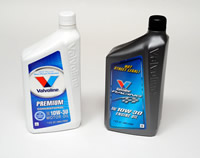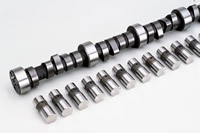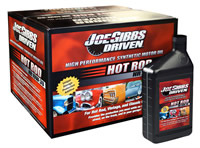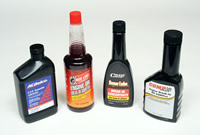Engine Oil Deep Dive - CAC's Comprehensive Look at Engine Oil and Flat-Tappet Camshaft Durability - Page 5 of 6
 |
 |
© 2009 by Hib Halverson
No use without permission, All Rights Reserved
![]() Discuss this article
Discuss this article
If you prefer petroleum-based oil designed specifically for high-performance, high-rpm gasoline engines, a great choice is Valvoline "VR-1 Racing Oil". There are many products in Ashland Oil's "Valvoline Racing" line, but VR-1 is the only one having detergents necessary for street use. Its phos content is 1200 PPM.
Some Corvette owners want synthetic oil. There are three synthetic base stocks: highly refined mineral oil (API Group III), synthesized hydrocarbon or poly-alpha-olefin (PAO)(Group IV) and polyol-ester (Group V).
Because of extensive marketing and that it's been factory fill on Corvette since 1992, The best known synthetic is Exxon-Mobil's "Mobil 1" which is a mix of Group III and IV base stocks. While a wide range of Mobil 1s are available, only one meets (just barely) our requirements for use in flat-tappet engines, "Mobil 1 High-Mileage" 10W30, with 1000 PPM nominal phosphorous content.
Joe Gibbs Racing's solution to cam failures was to develop its own oils for racing flat tappet cams, use it in their NASCAR Sprint Cup motors, then later, sell it to the public. Joe Gibbs Driven Racing Oil markets "Hot Rod Oil 10W30" a blend of Group III and IV base stocks with enough ZDP to make about 1200 PPM phosphorous. Additionally, this oil is good for collector cars because it has an anticorrosive additive package chosen for engines in cars which see periods of storage. Industry rumors are that the Lubrizol Corporation, which developed zinc dithiophosphate (ZDP) back in the 1940s and whose products, today, are benchmarks in the additive industry, had a key role in the Driven Racing Oil development. JGR neither confirms nor denies that, but if it's true; Coach Gibbs' oil is a good choice for Corvette flat-tappet engines.
Many oil experts believe and we agree that, regardless of price, the best engine oils are polyol-ester synthetics. Because of its ester base, an outstanding choice for any Vette engine is Red Line Synthetic Oil Corporation's "10W30 Engine Oil". It has nominal phosphorous content of 1200 PPM, so it's ideal for flat tappet cams. Because esters contain oxygen and hydrocarbons do not, any ester-based lubricant has an inherent affinity for metal. In layperson's terms, ester-based synthetics cling to wear surfaces offering an extra protection Group III or IV-based oils may not. When it comes to high temperature, high shear conditions in high performance engines, ester synthetics are the obvious choice if ultimate performance, reliability and durability are desired. On the downside, ester base stocks are the most expensive and, expectedly, Red Line products are priced accordingly but, if you run your Corvette hard; they can be worth the price.
Additives
Executive summary: If you use the proper oil in the first place, other than for break-in of a new cam and lifters; you don't need an additive.
In fact, it is possible that some additives marketed to increase ZDP may contain substances that work at cross-purposes to some oils' "built-in" additive packages and, in the end, may actually degrade that oil's performance. Bottom line, follow our oil suggestions and, except for break-in; you don't need additives.
That said, additives are deeply rooted in automotive culture and some Vettesters insist on "fortifying" mass-marketed engine oil. If that's you, at least pick one with known contents. That way, you can add the correct amount to gain the appropriate phosphorous level.
We researched four additives. The first was is a General Motors product. The dealer version (PN 88862586) is branded "Cam and Lifter Prelube". The aftermarket version ACDelco sells (PN 88862587) is "E.O.S. Assembly Lubricant". We spectrographically analyzed a sample and its phosphorous content is about 4500 PPM. To raise a GF-4 oil to 1100-1200 PPM phosphorous, add 2 1/2-oz of either product per quart of oil in your crankcase.
Crane Cams' "Superlube" facilitates cam/lifter break-in. Crane says it can, also, enhance EP lubrication. We analyzed a sample and it has a whopping 107000 PPM (a hair over 10%) phosphorous number. To increase a GF-4's phos content to 1100-1200 PPM, add 1/10-oz (3-ml) of Superlube to each quart of oil.
"Cam Break-In" from Comp Cams, also, designed as a break-in supplement, can improve oils with low phos content. We analyzed it and found: 1) it's active ingredient is molybdenumdithiophosphate ("MolyDTP") rather than ZDP and 2) its nominal phosphorous content is 8400 PPM. Add 1 1/2-oz per quart of oil to bring a GF-4 to 1100-1200 PPM phos.
Red Line Oil's new "Engine Oil Break-In Additive" is designed for both break-in and regular use. Unlike the previous three, it has an ester base, so it offers some lubrication benefits of ester-based engine oils. Red Line told us that it has enough ZDP to result in 18700 PPM phos., so use 2/3-oz. to every quart of oil to bring a GF-4 to 1100-1200 PPM phosphorous.
Other additives, claiming to improve cam durability, range from proverbial "snake oils" to products of practical use to those insisting on additives. If you chose an additive other than above, pick one for which you can ascertain phosphorous content and, then, use enough to raise your oil's nominal phos to 1100-1200 PPM. Once you know the additive's phos content, the formula is: desired phosphorous increase in PPM x 28.8 ÷ additive phos content in PPM = fluid ounces of additive per qt. of oil. For example, with Red Line Engine Oil Break-In Additive: 400 x 28.8 / 18,700 = 0.616 ounces per qt., or, rounded up, 2/3-oz. This formula assumes densities of .90 g/ml. and 1.0 g/ml for the oil and additive respectively, but will be accurate within 10% for most other cases.
Lastly, if you think since the right amount of ZDP is good then more is better; you're wrong. If durability of 50,000 miles or more is the goal, more than 1600 PPM, over a long period of time, because of potential chemical wear of the cam lobes and lifter faces, is not advised.
Racing Cams and Racing Oil
In spite widespread use of roller lifters, are there still radical, flat-tappet racing cams? You bet. NASCAR Sprint Cup mandates flat tappets and, on tracks like Michigan, Pocono and Fontana, over half the race is run above 9000 rpm. But...they use steel billet camshafts and diamond-like carbon-coated, tool steel lifters. The valve train, alone, in a Cup motor costs $15,000, so maybe that's not a relevant comparison.
"We still sell 'radical' flat tappet camshafts on the normal, cast proferal (gray iron) cores," Crane Cam's Chase Knight tells us. "Some are due to rules that specify no rollers. In other cases, it's due to cost considerations."

The same company may sell both engine oil and racing oil. In some cases, such as these Valvoline products, the difference in appearance between the engine oil container and the racing oil container helps the consumer differentiate. In other cases, the differences might not be as apparent. In any event, always read the container's la-bel before buying to make sure it's the right oil for your engine.
Image: Author
Since the 1950s, cams have been phosphate-coated to improve break-in characteristics, however, modern technology has developed newer surface treatment options which improve durability of flat-tappet racing cams. For example, Comp Cams offers optional nitriding of its flat-tappet products and we recommend anyone ordering an all-out racing grind from Comp consider that extra.
"Racing" oil is different from "engine" oil in several ways. It has enough ZDP to make at least 1200 PPM phosphorous. Some racing oils have far more - too much for engines with catalytic converters and enough to cause chemical wear if the cam is subjected to long-term street use. Most racing oils have little or none of the detergents necessary for street use. Most racing oils lack the enough anticorrosive additives for the periods of non-operation typical of classic or collector cars.
If your engine is truly a racing engine, then racing oil, along with frequent oil changes, is the obvious choice, however, if you have a racing engine in a street-driven Corvette or a street engine with some racing parts in it; use oils listed under "Solutions".
Valvoline Racing Oil has been around a long time and a brand for which phosphorous information is easy to obtain. There are two types, "Not Street Legal Racing Oil" and "Not Street Legal Synthetic Racing Oil". There are, in fact, no laws regulating its use. Valvoline brands that way to deter customers from using its racing oils in road cars because, while they have a modest level of detergents and anticorrosives, they have less than required for the durability most street car users expect. Vavoline Racing Oils have 1200 PPM nominal phosphorous content. Most flat tappet racing engines should use the synthetic 10W30. For further information, contact Ashland, Inc.
Joe Gibbs' core market is race oils. The best for a flat-tappet engine in a Vette is "XP3", a synthetic 10W30 with about 1200 PPM phosphorous. There are other choices in the Driven Racing Oil line, too. More info? Contact Joe Gibbs Racing.
Red Line has ester-based, synthetic Race Oils for everything from racing motorcycles to Top Fuel Dragsters, most with 2500 PPM phosphorous. Red Line SAE30 Race Oil (actually a 10W30 due to ester-bases having "natural" multiviscosity properties) is best for most flat tappet race engines in Vettes. Ester-based oils are recommended if the engine's sustained engine oil temperature is 275°-300°F. More info? Contact Red Line Oil.
 |
 |


